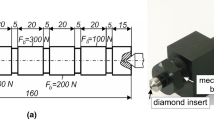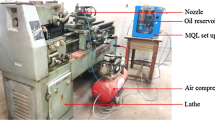Abstract
Diamond burnishing (DB) is a static mechanical surface treatment based on severe surface plastic deformation aimed at significant improvement in the surface integrity and operating properties of the treated component. Very often, DB is unjustifiably perceived of as typical smoothing burnishing. In the present article, it is shown that DB can be conducted as smoothing, deep, or mixed burnishing depending on the particular combination of process governing factors employed. Optimizations of the DB process for 41Cr4 steel under different criteria are conducted in order to obtain the optimal parameters of different DB processes. The choices of governing factors and objective functions (roughness and fatigue limits), which are obtained on the basis of planned experiments and regression analyses, are fully justified. By means of one-objective optimizations, the uncompromising optimum values of the objective functions and the corresponding optimum values of the governing factors of smoothing and deep DB processes are obtained. A new optimization procedure for solving a multi-objective optimization task is developed in order to obtain compromise optimal values simultaneously with the objective functions and governing factors of the mixed DB process. In order to highlight the advantages of the proposed optimization procedure, the multi-objective task solution is compared with the results obtained via some known methods, i.e., the compromise weight vector and function of the losses methods.












Similar content being viewed by others
Abbreviations
- f :
-
Feed rate
- F b :
-
Burnishing force
- F loss :
-
Function of the losses
- k :
-
Number of subintervals
- m :
-
Number of objective functions
- r :
-
Deforming diamond radius
- R :
-
Cycle asymmetry factor
- R a :
-
(Roughness)
- v :
-
Burnishing velocity
- x i :
-
Coded governing factor
- \( {x}_i^{\ast } \) :
-
Optimal value
- \( {\tilde{x}}_i \) :
-
Natural governing factor
- {X}:
-
Vector of governing factors
- {X∗}:
-
Vector of optimal governing factors
- \( \overrightarrow{Y}\left(\left\{X\right\}\right) \) :
-
Vector of objective functions
- Y j :
-
Objective function
- \( {Y}_j^{\ast } \) :
-
An uncompromising optimum value
- Γ x :
-
Factor space
- ε :
-
Small positive number
- σ −1 :
-
Fatigue limit
- CNC:
-
Computer numerical control
- DB:
-
Diamond burnishing
- SB:
-
Slide burnishing
- SI:
-
Surface integrity
- WP:
-
Working point
References
Korzynski M (2007) Modeling and experimental validation of the force-surface roughness relation for smoothing burnishing with a spherical tool. Int J Mach Tools Manuf 47:1956–1964
Ecoroll Catalogue (2006) Tools and Solutions for Metal Surface Improvement. Ecoroll Corporation Tool Technology, Ohio
Balland P, Tabourot L, Degre F, Morean V (2013) An investigation of the mechanics of roller burnishing through finite element simulation and experiments. Int J Mach Tools Manuf 65:29–36
Hadadian A, Sedaghati R (2019) Investigation on thermal relaxation of residual stresses induced in deep cold rolling of Ti-6Al-4V alloy. Int J Adv Manuf Technol 100(1–4):877–893
Mombeini D, Atrian A (2019) Experimental and numerical investigation of the effects of deep cold rolling on the bending fatigue tolerance of C38500 brass alloy. Int J Adv Manuf Technol 97(5–8):3039–3053
Maximov JT, Duncheva GV, Anchev AP, Ganev N, Dunchev VP (2019) Effect of cyclic loading on fatigue performance of slide burnishing components made of low-alloy medium carbon steel. Fatigue Fract Eng Mater Struct 42(6):1414–1425
Maximov JT, Anchev AP, Duncheva GV, Ganev N, Selimov KF, Dunchev VP (2019) Impact of slide diamond burnishing additional parameters on fatigue behaviour of 2024-T3 Al alloy. Fatigue Fract Eng Mater Struct 42(1):363–373
Maximov JT, Anchev AP, Dunchev VP, Ganev N, Duncheva GV, Selimov KF (2017) Effect of slide burnishing basic parameters on fatigue performance of 2024-T3 high-strength aluminium alloy. Fatigue Fract Eng Mater Struct 40(11):1893–1904
Buldum BB, Cagan SC (2018) Study of ball burnishing process on the surface roughness and microhardness of AZ91D alloy. Exp Tech 42(2):233–241
Sachin B, Narendranath S, Chakradhar D (2018) Experimental evaluation of diamond burnishing for sustainable manufacturing. Mater Res Express 5(10):106514. https://doi.org/10.1088/2053-1591/aadb0a
Shiou FJ, Banh QN (2016) Development of an innovative small ball-burnishing tool embedded with a load cell. Int J Adv Manuf Technol 87(1–4):31–41
Teimouri R, Amini S, Bami AB (2018) Evaluation of optimized surface properties and residual stress in ultrasonic assisted ball burnishing of AA6061-T6. Measurement 116:129–139
Revankar G, Shetty R, Rao S, Gaitonde V (2017) Wear resistance enhancement of titanium alloy (Ti-6Al-4V) by ball burnishing process. J Mater Res Technol 6(1):13–32
El-Taweel TA, El-Axir MH (2009) Analysis and optimization of the ball burnishing process through the Taguchi technique. Int J Adv Manuf Technol 41:301–310
Basak H, Goktas HH (2009) Burnishing process on al-alloy and optimization of surface roughness and surface hardness by fuzzy logic. Mater Des 30:1275–1281
Maximov JT, Duncheva GV, Anchev AP, Ichkova MD (2019) Slide burnishing – review and prospects. Int J Adv Manuf Technol. https://doi.org/10.1007/s00170-019-03881-1
Stalin John MR, Vinayagam BK (2014) Optimization of nonlinear characteristics of ball burnishing process using Sugeno fuzzy neural system. J Braz Soc Mech Sci Eng 36:101–109
Deshmukh A, Patil R (2015) Analyasis and optimization of roller burnishing process on cylindrical surface micro-hardness of aluminium alloy. International journal of innovative research in science. Eng Technol 4:6044–6055
Hassan AM, Al-Jalil HF, Ebied AA (1998) Burnishing force and number of passes of ball passes for the optimum surface finish of brass components. J Mater Process Technol 83:176–179
Laouar L, Hamadache H, Saad S, Bouchelaghem A, Mekhilef S (2009) Mechanical surface treatment of steel – optimization parameters of regime. Phys Procedia 2:1213–1221
Sagbas A (2011) Analysis and optimization of surface roughness in the ball burnishing process using response surface methodology and desirability function. Adv Eng Softw 42:992–998
Saldana-Robles A, Plascencia-Mora H, Aguilera-Gomez E, Saldana-Robles A, Marquez-Herrera A (2018) Diosdado-De la Pena JA. Influence of ball-burnishing on roughness, hardness and corrosion resistance of AISI 1045 steel. Surf Coat Technol 339:191–198
Shinde NM, Kurkuter VK (2017) Optimization of single roller burnishing operation for surface roughness of aluminium alloy using artificial neutral network. Int J Mech Eng 43(2):1289–1293
Solanki RG, Patel KA, Dhruv RB (2016) Parametric optimization of roller burnishing process for surface roughness. IOSR J Mech Civ Eng 13(3):21–26
Babu PR, Ankamma K, Prasad TS, Raju AVS, Prasad NE (2012) Optimization of burnishing parameters and determination of select surface characteristics in engineering materials. Sadhana 37(4):503–520
Datta S, Bandyopadhyay A, Pal PK (2008) Grey-based Taguchi method for optimization of bead geometry in submerged arc bead-on-plate welding. Int J Adv Manuf Technol 39(11–12):1136–1143
Sathiya P, Abdul Jaleel MY (2010) Grey-based Taguchi method for optimization of bead geometry in laser bead-on-plate welding. Adv Prod Eng Manag 5(4):225–234
Esme U (2010) Use of grey based Taguchi method in ball burnishing process for the optimization of surface burnishing and microhardness of AA7075 aluminium alloy. Mater Technol 44:129–135
Maximov JT, Duncheva GV (2012) Finite element analysis and optimization of spherical motion burnishing of low-alloy steel. Proc Inst Mech Eng C J Mech Eng Sci 226(1):161–176
Stalin John MR, Vinayagam BK (2011) Optimization of ball burnishing process on tool steel (T215Cr12) in CNC machining Centre using response surface methodology. Arab J Sci Eng 36(7):1407–1422
Stalin John MR, Banerjee N, Shrivastava K, Vinayagam BK (2017) Optimization of roller burnishing process on EN-9 grade alloy steel using response surface methodology. J Braz Soc Mech Sci Eng 39(8):3089–3101
Mohammadi F, Sedaghati R, Bonakdar A (2014) Finite element analysis and design optimization of low plasticity burnishing process. Int J Adv Manuf Technol 70(5–8):1337–1354
Kurkute V, Chavan ST (2018) Modeling and optimization of surface roughness and microhardness for roller burnishing process using response surface methodology for aluminum 63400 alloy. Procedia Manuf 20:542–547
Nguyen TT, Le XB (2018) Optimization of interior roller burnishing process for improving surface quality. Mater Manuf Process 33(11):1233–1241
Moussa NB, Gharbi K, Chaieb I, Fredj NB (2019) Improvement of AISI 304 austenitic stainless steel low-cycle fatigue life by initial and intermittent deep rolling. Int J Adv Manuf Technol 101(1–40):435–449
Reemsnyder HS (1961) The fatigue behavior of structural steel weldments – a literature survey, Lehigh University. p 152. Fritz Laboratory Reports Paper 1818
Maximov JT, Duncheva GV, Anchev AP, Ganev N, Amudjev IM, Dunchev VP (2018) Effect of slide burnishing method on the surface integrity of AISI 316Ti chromium-nickel steel. J Braz Soc Mech Sci Eng 40:194–114. https://doi.org/10.1007/s40430-018-1135-3
Vuchkov IN, Vuchkov II (2009) QStatLab Professional, v. 5.5 – Statistical Quality Control Software. User’s Manuel, Sofia
Lobanowski J, Ossowska A (2006) Influence of burnishing on stress corrosion cracking susceptibility of duplex steel. J Achievemens Mater Manuf Eng 19(1):46–52
Stoyanov SK (1993) Optimization of technological objects. Technika, Sofia, (in Bulgarian)
Funding
This work was supported by the European Regional Development Fund within the OP “Science and Education for Smart Growth 2014-2020,” Project CoC “Smart Mechatronics, Eco- and Energy Saving Systems and technologies”, №BG05М2ОР001-1.002-0023.
Author information
Authors and Affiliations
Corresponding author
Additional information
Publisher’s note
Springer Nature remains neutral with regard to jurisdictional claims in published maps and institutional affiliations.
Rights and permissions
About this article
Cite this article
Maximov, J.T., Duncheva, G.V., Anchev, A.P. et al. Smoothing, deep, or mixed diamond burnishing of low-alloy steel components – optimization procedures. Int J Adv Manuf Technol 106, 1917–1929 (2020). https://doi.org/10.1007/s00170-019-04747-2
Received:
Accepted:
Published:
Issue Date:
DOI: https://doi.org/10.1007/s00170-019-04747-2




